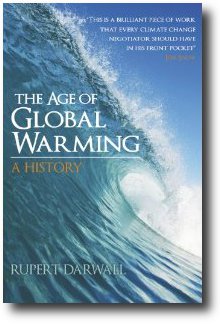 This is a guest post by Messenger.
This is a guest post by Messenger.
I take my hat off to Rupert Darwall for tackling this knotty and diverse subject, so full of devious twists and turns and sometimes almost unbelievable actions and decisions. It is a fascinating, if complicated story, creating an important record of the machinations producing the madness of crowds that has overtaken so many governments and people around the world.
Darwall pins down the seminal moments, the recurrent scares, and the prime movers, beginning with Malthus and Malthusians and identifying the publication of Rachel Carson’s Silent Spring (1962) as an important watershed. He notes the innate pessimism of the much of the environmental movement, typified by the Club of Rome in 1972 when it asked if the human species could survive without falling into a state of “worthless existence” and its development into the depressing topos that man must be at fault in one way or another for all environmental damage, and that therefore we must do- and apparently be persuaded or forced to do- without. It is this demand for self-sacrifice, originally aimed at Western nations, that has now become an attempt by our “global governors” to hold back development world-wide.
Darwall identifies another watershed moment at the Toronto summit in 1988 seen as the time when the scientific method began to be undermined, standards slipped and among some climate scientists at least, verification was apparently no longer a requirement. He considers that many scientists pretend to know more than they do about the workings of the climate, and the environmental movement and the media, “with its ever present appetite for alarmism,” have for many years reinforced this fear by constantly stressing the imminence of disaster in spite of repeated failures of calamity to appear. Politicians and political advisers have aggravated matters through their uncritical acceptance of the prognosis and sometimes nonsensical actions such as the demonising of coal and carbon dioxide, aimed at preventing the so-called disease. Darwall also analyses the contribution of other institutions, the IPCC, The Royal Society and the green NGOs to the creation of the current parlous and polarised state we are in.
Many of these matters are well known to climate blog readers, and from time to time I found the book somewhat fragmentary, chopping and changing from one subject to another with great rapidity. This is minor criticism, however, because it is such a complicated subject to deal with, with so many ramifications, and the assembly of this detailed history in one volume makes it a valuable, and we hope, noticeable contribution to the records. Darwall’s closing chapter sums up the crucial dilemma that has been created by the events recorded in this book: “In believing scientists and politicians can solve the problems of a far distant future, the tangible needs of the present are neglected.”
The Age of Global Warming: A History Rupert Darwall (London 2013)